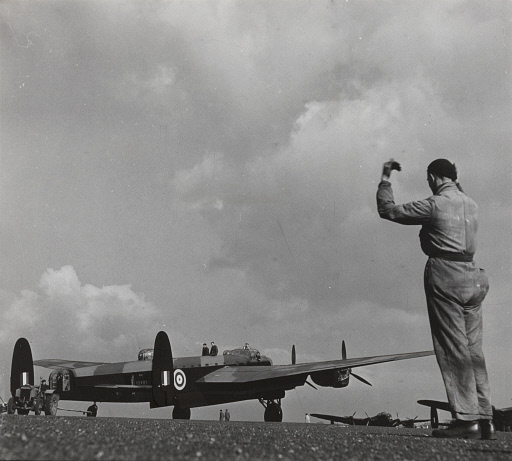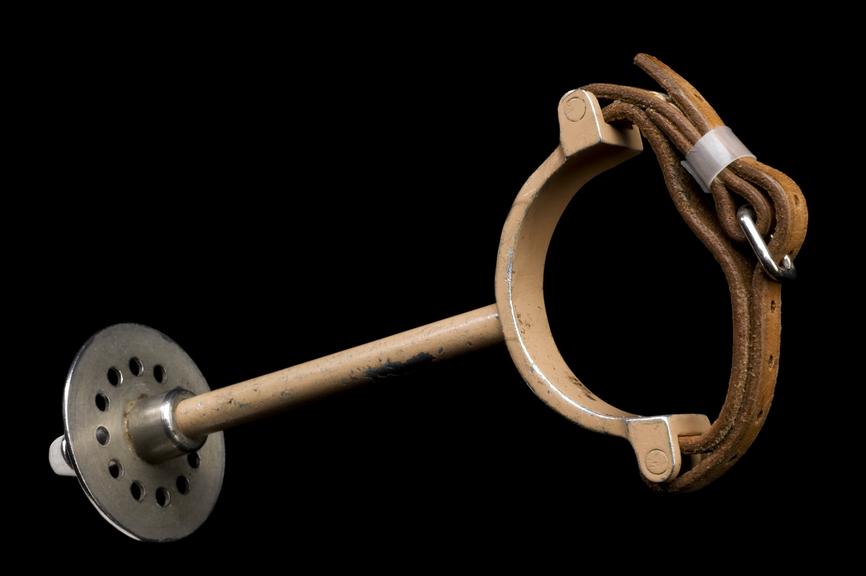At a recent LATES evening at the museum, this mysterious object was taken out from permanent storage and presented to members of the public during our regular object handling, “Hidden Gems” event. We asked if anyone knew what the item was and (perhaps unsurprisingly) no-one correctly identified what it was used for, with guesses ranging from a beverage cup holder through to a piece of machinery!
Although initially enigmatic, this object does in fact contain a fantastic back story of bravery, strength in adversity and even a little bit of sporting prowess…
The object was made by Steeper, a company still in existence today and based in Leeds, England. It was made for, and used by, the distinguished Royal Air Force pilot Sir Augustus ‘Gus’ Walker, a man who rose to the highest military ranks by becoming Air Chief Marshal of the RAF and Deputy Commander-In-Chief of NATO forces in Europe. This would, of course, be a tremendous achievement for any individual; however, Walker’s accomplishments are made all the more remarkable by the fact that in 1942 he lost his right arm below the elbow in an airfield accident.
Image of Sir (George) Augustus Walker, by Hay Wrightson Ltd. From the National Portrait Galleries’ Photograph Collection. NPG x180733Walker was not flying an aircraft at the time of the incident, but was in the control tower when he noticed that a Lancaster bomber was on fire whilst taxiing across the runway in readiness for a mission. He hurried out to warn the pilots, but was caught in the subsequent explosion.

Rumour has it that upon leaving the airfield in an ambulance he instructed the doctor to telephone RAF high command and ask if they would welcome back a one armed officer in 2 months’ time. True to his word he was back to work inside 2 months and flying aeroplanes again soon after that!
This object, as Walker’s own unique prosthetic limb attachment, was subsequently made so that he could continue to fly aircraft despite having lost half of one arm. He connected the attachment to the end of this prosthetic arm, tied the leather strap around the joystick and controlled the aircraft with his left hand.

Walker never let his prosthetic limb limit him, and throughout his RAF career he continued to fly new generations of aircraft including the Canberra and Vulcan jet bombers.
As well as being an excellent military man, Walker was also blessed with enviable sporting talents. He was captain of the RAF rugby team and in 1939 earned two full caps for the England team in matches against Ireland and Wales. Walker’s story emphasises the strong historical links that exist between the military and rugby union; a connection that continues to the present day.
Walker even rose to the highest administrative ranks of his chosen sport, as between 1965 and 1966 he had a spell as president of the Rugby Football Union (RFU).
Many who met and served with Walker described him as an exceptional serviceman, strong leader and a true gentleman. The high esteem in which he was held has not diminished, as in 2006 a blue plaque was erected in Walker’s honour by a local historical society at his former family home in Garforth, West Yorkshire.
Upon his death in 1987 it was commented that the RAF would never see the like of Walker again, and although his custom made prosthetic is initially mysterious to those who encounter it, it is in fact wonderfully emblematic of a truly unique and remarkable individual.
One comment on “A mysterious object”
Comments are closed.
As Churchill rightly said, “never in the field of human conflict was so much owed by so many to so few.”